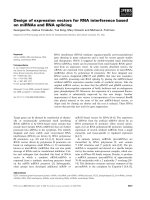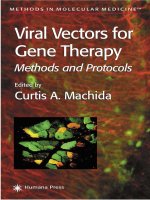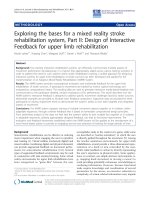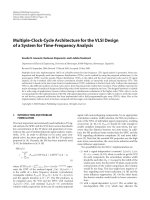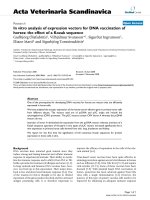Design of viral vectors for improved gene delivery
Bạn đang xem bản rút gọn của tài liệu. Xem và tải ngay bản đầy đủ của tài liệu tại đây (5.25 MB, 244 trang )
DESIGN OF VIRAL VECTORS FOR IMPROVED GENE
DELIVERY
IVY HO AI-WEI
(MSc, Leicester University, UK)
A THESIS SUBMITTED FOR
THE DEGREE OF DOCTOR OF PHILOSOPHY
DEPARTMENT OF PHYSIOLOGY
NATIONAL UNIVERSITY OF SINGAPORE
2004
ACKNOWLEDGEMENTS
First and foremost, I am grateful to Dr. Paula Lam for supervising this project and for her
endless support, guidance, advice and friendship.
I would like to extend my gratitude to Prof. Hui Kam Man for valuable ideas and discussions
throughout the duration of this project.
I would also like to thank Dr. Wang Nai-dy for his support and contributions to this project.
I would also like to acknowledge Dr. R Müller (Institute of Molecular Biology and Tumor
Research, Germany) for providing us with the plasmids CMV.GN and 8GalcycA, Dr. PD
Nisen (University of Texas Southwestern Medical Center, Dallas, TX) for providing us with
the glial specific promoter, Dr. MV Clement (National University of Singapore, Singapore) for
providing the cDNA for FADD, and Dr. Thomas J (Department of Neurosurgery, Singapore
General Hospital) for providing us with the primary glioma biopsy.
This research is supported by grants from the Singapore Biomedical Research Council,
Singapore National Medical Research Council and Singhealth Cluster Research Grant.
My sincere appreciation to past and present members of the lab, especially Gan Shu Uin and
Gao Hui, who have provided immense support during trying moments. Thanks also to
members of the Laboratory of Cancer Genomics for the fun and laughter; I have enjoyed our
many excursions together.
Finally, I would like to express my deepest gratitude to my family and friends for their support
and encouragement.
i
TABLE OF CONTENTS
Acknowledgements
Table of Contents
Summary
List of Tables
List of Figures
Abbreviations
List of Publications
i
ii
viii
ix
x
xiii
xiv
Chapter 1
1
Introduction
1.1 Brain tumors
1.2 Invasiveness of glioma cells
1.3 Current treatment regime for brain tumors
1.3.1Why do current therapies fail?
1.3.2 Gene therapy of gliomas
1.4 Criteria of an ideal delivery vector system
1.5 Delivery Modalities
1.5.1 HSV-1 vectors
1.5.1.1 Biology of HSV-1 vectors
1.5.1.2 HSV-1 vectors as gene delivery vehicles
1.5.1.2.1 Recombinant HSV-1
1.5.1.2.2 Replication competent HSV-1
1.5.1.2.3 Replication defective HSV-1 amplicons
1.6 Transcriptional regulation system
1.6.1 Tetracycline-regulated system
1.6.2 Dimerizer-regulated system
1.6.3 Limitations of inducible systems
1.7 Strategies to target dividing, recurrent tumor cells
1.7.1 Gal4/p56lck system
1.7.2 Gal4/NF-YA system
1.7.2.1 Current strategy
1.8 Aims of this study
2
5
5
8
8
10
11
12
13
15
16
16
17
21
21
22
22
22
23
23
24
24
Chapter 2
26
Materials and Methods
2.1 Materials
2.1.1 Geniticin
2.1.2 Puromycin
2.1.3 Dulbecco’s modified Eagle’s medium (DMEM) culture medium
2.1.4 Cells-freezing medium
2.1.5 Lovastatin
2.1.6 Mevalonate
2.1.7 Dithio-DL-threitol (DTT)
2.1.8 RNase A (DNase Free)
2.1.9 Propidium iodide (PI) solution
2.1.10 Sucrose solution
2.1.11 Solution I for DNA extraction
2.1.12 Lysis solution for DNA extraction
2.1.13 Neutralizing buffer for DNA extraction
27
27
27
27
27
27
28
28
28
28
28
28
29
29
ii
2.1.14 Lysis buffer for isolating Hirt’s DNA
2.1.15 Tris-EDTA (TE)
2.1.16 Cesium chloride/TE/ ethidium bromide (EtBr) solution
2.1.17 TE-saturated Butanol
2.1.18 Diethylpyrocarbonate (DEPC) water
2.1.19 Preparation of temozolomide (TMZ)
2.1.20 Ampicillin
2.1.21 Kanamycin
2.1.22 Chloramphenicol
2.1.23 Luria broth (LB)
2.1.24 SOB (1L)
2.1.25 Escherichia coli strain ER2537
2.1.26 5-bromo-4-chloro-3-indolyl-β-D-galactoside (X-Gal)
2.1.27 Isopropyl β-D-thiogalactoside (IPTG)
2.1.28 Tris-buffered saline (TBS)
2.1.29 Peptides
2.1.30 Protein lysis buffer
2.1.31 Luciferase assay buffer
2.1.32 Luciferin buffer
2.1.33 Luciferin
2.1.34 Preparation of Ponseau S
2.1.35 Resolving gel (10%)
2.1.36 Stacking gel (5%)
2.1.37 Protein loading buffer
2.1.38 SDS electrophoresis buffer
2.1.39 Protein transfer buffer
2.1.40 Western hybridization blocking buffer
2.1.41 Polyacrylamide gel electrophoresis (PAGE)
2.1.42 Binding buffer for isolation of nuclear extract for Electromobility
shift assay (EMSA) (Wu et al., 2001)
2.1.43 Buffer A for isolation of nuclear extract (Wu et al., 2001)
2.1.44 Buffer C for isolation of nuclear extract (Wu et al., 2001)
2.1.45 Tris-Acetate EDTA buffer (TAE)
2.1.46 Fixative
2.1.47 Blocking buffer for Immunohistochemistry
2.1.48 Antibodies
2.1.49 Animals
2.2 General Methods
2.2.1 Tissue culture
2.2.1.1 Cell lines
2.2.1.2 Culture conditions of cell lines
2.2.1.3 Subculturing of cells
2.2.1.4 Cryopreservation of cells
2.2.1.5 DNA transfections
2.2.1.6 Synchronization of cells and cell cycle analysis
2.2.2 Packaging of HSV-1 amplicon vector using helper virus-free system
2.2.2.1 BAC fHSV∆pac∆27 0+ packaging
2.2.2.2 Cosmids C6∆a48∆a packaging
2.2.2.3 Harvesting of virions
2.2.2.4 Sucrose gradient ultracentrifugation
2.2.2.5 Determination of viral titer
2.2.2.6 Amplicon vector transduction
2.2.3 Nucleic acid isolation
2.2.3.1 Isolation of plasmid DNA-mini alkaline lysis method
29
29
29
29
29
30
30
30
30
30
30
31
31
31
31
31
31
32
32
32
32
32
32
33
33
33
33
33
33
33
34
34
34
34
34
35
36
36
36
36
37
37
37
38
39
39
39
39
39
40
40
41
41
iii
2.2.3.2 Isolation of plasmid DNA, BAC and cosmid DNA by alkaline
lysis method
2.2.3.3 Isolation of total RNA from cultured cell lines
2.2.3.4 Isolation of total RNA from tumor tissues
2.2.3.5 Quantification of nucleic acid concentration
2.2.3.6 Extraction of viral DNA from brain tissues
2.2.4 Protein isolation and analysis
2.2.4.1 Total cell lysate
2.2.4.2 Determination of protein concentration
2.2.4.3 Assay for luciferase activity
2.2.4.4 Assay for FasL protein expression
2.2.4.5 Assay for FADD protein expression
2.2.4.6 SDS-polyacrylamide gel electrophoresis (SDS-PAGE)
2.2.4.7 Western hybridization
2.2.4.8 Hematoxylin and Eosin (H&E) staining
2.2.4.9 Immunohistochemistry staining
2.2.4.10 Immunofluorescence staining
2.2.5 Recombinant DNA techniques
2.2.5.1 Electrophoresis of plasmid DNA or PCR fragments
2.2.5.2 Purification of DNA fragments
2.2.5.3 Removal of nucleotides
2.2.5.4 Restriction endonuclease digestions
2.2.5.5 Dephosphorylation
2.2.5.6 Ligation reaction
2.2.5.7 Transformation of bacterial cells by the heat shock method
2.2.5.8 Polymerase Chain Reaction (PCR)
2.2.5.9 Reverse Transcriptase-PCR (RT-PCR)
2.2.6 Cell viability assay using trypan blue exclusion assay
2.2.7 Terminal deoxynucleotide transferase dUTP Nick End labeling
(TUNEL) assay
2.2.8 Animal models
2.2.8.1 Establishment of subcutaneous (s.c.) tumor model
2.2.8.2 Establishment of intracranial (i.c.) tumor model
2.2.8.3 Establishment of dGli36-SCID8 cells
2.2.9 Statistical analysis
Chapter 3
Characterization of the cell cycle-regulated HSV-1
amplicon vector
3.1 Background
3.1.1 Cell cycle regulation
3.1.1.1 Transcriptional repression mediated by E2F
3.1.2 Cyclin A
3.1.3 Regulation of the cyclin A transcription
3.1.4 CDF-1
3.1.5 Recombinant transcriptional activator (RTA) system
3.1.5.1 Methods for synchronizing cells at G1 phase
3.1.6 Liver regeneration model
3.1.7 Aim of research
3.2 Methods
3.2.1 Construction of the cell cycle regulated amplicon plasmids
3.2.2 Transfection of oligomers
41
42
43
43
43
43
43
44
44
44
44
45
46
46
47
47
48
48
48
48
48
49
49
49
49
50
50
51
51
51
52
52
52
54
55
55
57
57
58
58
62
63
65
65
66
66
66
iv
3.2.3 Preparation of nuclear extracts
3.2.4 Labeling of oligonucleotide probes
3.2.5 Electrophorectic mobility shift assays (EMSA)
3.2.6 Hepatectomy
3.2.7 Isolation of single cells for FACS analysis
3.3 Results
3.3.1 Construction of a cell cycle-regulatable HSV-1 amplicon viral vector
3.3.2 Enhanced transgene expression via a single-vector construct
3.3.3 Synchronization of cells at early G1 phase using lovastatin
3.3.4 Cell cycle-regulated transgene expression mediated by HSV-1
amplicon plasmid vectors in NIH3T3
3.3.5 Cell cycle-regulated transgene expression mediated by HSV-1
amplicon plasmid vectors in a series of cell lines in vitro
3.3.6 Interaction of the CDE/CHR regulatory region with CDF-1 repressor
protein
3.3.7 Cell cycle mediated transgene activity can be abolished in the
presence of competitor
3.3.8 Transgene expression can be switched on in resting cells
3.3.9 Packaging of amplicon viral vectors
3.3.10 Analysis of cell cycle-dependent transgene expression in pC8-36
amplicon viral vectors
3.3.11 Effect of transduction of viral vector on the cell cycle profile
3.3.12 Transgene expression is dosage dependent
3.3.13 Transgene expression is restricted to proliferating cells in vivo
3.4 Discussion
82
84
84
87
90
Chapter 4
94
Application of the cell cycle-regulated amplicon vector
4.1 Background
4.1.1 Apoptosis
4.1.2 Fas and Fas Ligand
4.1.3 FasL-induced apoptosis
4.1.4 Gene therapy using FasL and FADD
4.1.5 Aims of this study
4.2 Methods
4.2.1 Construction of pIH8GalFasL, pC8-FasL
4.2.2 Construction of pIH8GalFADD and pC8FADD
4.2.3 Real time RT-PCR
4.2.4 In vivo transduction
4.2.5 Statistical analysis
4.3 Results
4.3.1 Construction of a cell cycle-regulatable HSV-1 amplicon viral vector
that encodes or contains the human FasL and FADD gene
4.3.2 Cell death induced by FasL is regulated in a cell cycle-dependent manner
4.3.2.1 Conditioned medium harvested from FasL-transduced
cells induces apoptosis
4.3.3 Cell death induced by pC8-FADD is also cell cycle-dependent
4.3.4 Expression of FasL and FADD are correlated to cell cycling events
4.3.5 Co-expression of FasL and FADD enhanced apoptosis
4.3.6 Expression profile of FasL and FADD
4.3.7 FasL and FADD gene delivery in vivo suppresses tumor growth
4.3.8 Suppression of tumor growth is mediated by overexpression of
exogenous Fas or FADD
67
67
67
68
68
69
69
71
71
73
73
77
79
79
82
95
95
95
96
98
98
100
100
100
101
101
102
103
103
103
105
108
108
108
113
113
116
v
4.4 Discussion
Chapter 5
119
Strategies for targeting therapeutic gene expression to
glioma cells
5.1 Background
5.1.1 Transcriptional targeting
5.1.1.1 GFAP
5.1.1.2 GFAP promoter for transgene regulation
5.1.1.3 One step closer to clinical trials
5.1.1.3.1 Effect of chemotherapy on the cell cycle-regulated
amplicon vector
5.1.1.3.2 Stability of HSV-1 amplicon
5.1.1.3.3 Transduction efficiency of HSV-1 amplicon vector
5.1.1.3.4 Immunogenicity of HSV-1 amplicon
5.1.2 Vector retargeting
5.1.2.1 Phage display technology
5.1.3 Aims of this study
5.2 Methods
5.2.1 Plasmid constructs
5.2.2 In vivo transduction
5.2.3 Determination of the efficacy of FasL in s.c. tumor
5.2.4 Determination of the efficacy of FasL in i.c. tumor
5.2.5 Treatment with TMZ
5.2.6 Stability of pG8-18 viral vector
5.2.7 Transduction efficiency of pC8-36 and pG8-18 viral vector
5.2.8 Immunogenicity of HSV-1 amplicon vector
5.2.9 Phage display library biopanning
5.2.10 Amplification of phage clones
5.2.11 Titering of phage
5.2.12 In vivo targeting of MG11 phage to tumor xenograft
5.2.13 Formation of peptide/DNA complexes
5.2.14 Transfection of tumor cell lines
5.2.15 In vitro fluorescent peptide binding assay
5.2.16 In vivo fluorescent peptide binding assay
5.2.17 Statistical analysis
5.3 Results
5.3.1 Cell type-specific and cell cycle-regulated transgene expression
mediated by HSV-1 amplicon vectors in vitro
5.3.1.1 Cell type-specific and cell cycle-regulated transgene
expression mediated by HSV-1 amplicon vectors in vivo
5.3.1.2 Glial cell specific expression of FasL
5.3.1.3 Suppression of tumor growth is observed in glioma only
5.3.1.4 Effect of TMZ on dGli36 human glioma cells
5.3.1.4.1 TMZ caused accumulations of cells at G2/M phase
5.3.1.4.2 Effect of TMZ on transgene expression mediated
by pG8-18 in dGli36 cells
5.3.1.5 In vivo stability of the dual specific amplicon vector
5.3.1.6 Transduction efficiency in vivo
5.3.1.7 Assessing the immunogenicity of the cell cycle-regulated
vector
5.3.2 Identification of glioma specific peptide
122
123
123
124
124
126
126
126
127
128
130
131
132
133
133
133
133
134
134
134
135
135
136
136
137
137
138
138
139
139
139
140
140
144
144
147
152
152
152
155
158
161
164
vi
5.3.2.1 Enrichment of “glioma-specific” phage by in vitro
biopanning
5.3.2.2 Characterization of the binding epitopes of MG11 phage
in vitro
5.3.2.3 MG11 phage targets to human glioma xenograft in vivo
5.3.2.4 MG11 phage does not bind to normal brain tissue
5.3.2.5 In vitro binding of (K16)-MG11 to human glioma cells
5.3.2.6 (K16)-MG11 mediates expression of luciferase reporter
gene to glioma cells
5.3.2.7 Characterization of (K16)-MG11 peptide targeted delivery
in vitro and in vivo
5.4 Discussion
Chapter 6
Future Directions
164
167
167
170
170
174
176
181
188
6.1 Enhanced transgene regulation
6.2 Alternative therapeutic genes and glioma-specific promoters
6.3 Clinical application of the cell cycle-regulated amplicon vector
6.4 Combining vector targeting with transcriptional targeting
6.5 Conclusion
190
190
192
193
194
Bibliography
195
vii
SUMMARY
The major challenge of cancer gene therapy trial is the ability to target transgene expression to
a particular tumor cell type. As uncontrolled proliferation is a common characteristic of
malignant tumor cells, an attractive strategy for cancer gene therapy would be the use of
vectors carrying therapeutic genes that can be activated upon cellular replication. This
strategy may be of special clinical relevance for brain tumor therapy. One of the clinical
pathology of glioma is its highly invasive and diffuse nature, thus render complete surgical
resection impossible. In this study, we have attempted to design vectors by the incorporation
of regulatory elements that allow proliferation-dependent gene expression.
We have constructed a HSV-1 amplicon viral vector whereby the transgene expression is
controlled by cell cycle events. The strategy adopted is based on a G0/G1 specific
transcriptional repressor protein, CDF-1, that interacts with regulatory elements on the cyclin
A promoter. In non-dividing cells, the activation of the cyclin A promoter by an upstream
transactivator, Gal4/NF-YA fusion protein, is prevented by the presence of the CDF-1 protein.
In actively proliferating cells, transactivation could take place due to the absence of CDF-1.
Our results demonstrated that when all of these cell cycle-specific regulatory elements are
incorporated in cis into a single HSV-1 amplicon plasmid, the reporter luciferase activity is
greatly enhanced. As a further safety mechanism, the transgene cassette is placed under a glial
cell-specific promoter for glial cell specific transcription since most recurrent brain tumors
originate from glial-derived cells.
When these amplicon plasmids are packaged into
infectious but replication-defective HSV-1 amplicon viral vectors, the luciferase reporter
expression could be regulated in a glial cell specific and proliferation-dependent manner in a
variety of human glioma cell lines. These viral vectors are also demonstrated to be effective at
delivering therapeutic genes to actively proliferating tumor cells in glioma xenografts.
In addition, we have screened the phage display library for a glioma-specific sequence with
the aim of identifying molecules that target to glioma cells. We have isolated a novel human
glioma-specific peptide, MG11, which could target exogenous DNA specifically to a wide
array of human glioblastoma cells, in vitro and in vivo. The isolation of this MG11 peptide
provides the means to conjugate therapeutic agents for targeting. The combination of these
two strategies would ensure only those rapidly proliferating glioma cells that express the
receptor for the MG11 peptide would be infected by the amplicon vector, thus greatly facilitate
the expression of therapeutic gene to glioma cells. More importantly, the amount of viruses
needed to achieve a therapeutic response would be significantly reduced; hence, potential side
effects could be correspondingly minimized.
In summary, we have designed an HSV-1 amplicon based gene delivery system that is (i)
capable of incorporating a large transgene capacity; (ii) stable; (iii) safe; (iv) regulatable; (v)
capable of targeting to glioma cells.
viii
LIST OF TABLES
Table 1.1 Vectors and delivery systems for gene therapy
12
Table 5.1 Determination of transduction efficiency of amplicon viruses in vivo
160
Table 5.2 Comparison of percentage of GFP positive cells in both HSV-1
amplicon viral vectors infected and AdGFP infected HeLa cells
161
Table 5.3 Lists of peptides isolated from biopanning of human glioma cell
lines
166
ix
LIST OF FIGURES
Figure 1.1
Pathways to gliomagenesis
3
Figure 1.2
Model of distant recurrences in malignant glioma
6
Figure 1.3
MRI images of recurrent glioma
7
Figure 1.4
Structure of herpes simplex virus type-1
14
Figure 1.5
Diagram of HSV-1 amplicon vectors
18
Figure 1.6
Helper virus-free packaging system
20
Figure 3.1
Summary of cell cycle regulation
56
Figure 3.2
Cyclin A promoter sequence
59
Figure 3.3
Sequence alignment of the CDE/CHR region in the cdc25C, cdc2 and
cyclin A promoter
60
Figure 3.4
Summary of the dual-specificity system
64
Figure 3.5
Constructs used in this chapter
70
Figure 3.6
Single vector constructs containing both the activator and
the reporter module is much more efficient than cotransfection
72
Figure 3.7
Cell cycle profile of NIH3T3
74
Figure 3.8
Cell cycle regulated luciferase gene expression in NIH3T3
75
Figure 3.9
Analysis of cell cycle regulated transgene expression in human tumor
cell lines
76
Figure 3.10 Cell cycle dependent transgene expression can be abolished in the
presence of competitor
78
Figure 3.11 Interaction of the CDE/CHR regulatory region with CDF-1 repressor
protein
80
Figure 3.12 Luciferase transgene expression can be switched on in resting cells
transfected with pC8-36 amplicon plasmid
81
Figure 3.13 The effect of viral transduction on cell cycle regulated transgene
expression
83
Figure 3.14 HSV-1 infection do not alter the cell cycle profile
85
Figure 3.15 The effect of different viral dosage on the regulation of transgene
expression
86
x
Figure 3.16 Kinetics of liver regeneration following PHx
88
Figure 3.17 Transgene expression mediated by pC8-36 in PHx, mock-treated and
untreated mice
89
Figure 4.1
Fas/FasL mediated apoptosis
97
Figure 4.2
Cell cycle regulated amplicon vector constructs harboring either the
FasL or the FADD gene
104
Figure 4.3
Apoptotic effect mediated by FasL is specific for proliferating cells
106
Figure 4.4
Conditioned medium harvested from FasL-transduced proliferating
dGli36 cells induce apoptosis.
107
Figure 4.5
The function of FADD mediated by pC8-FADD is cell cycle-regulated
109
Figure 4.6
Expression of FasL and FADD mediated by pC8-FasL and pC8-FADD
is cell cycle-regulated
110
Combine effect of FasL and FADD overexpression was observed in
glioma cells
112
Figure 4.8
Expression profiles of FasL and FADD in vitro
114
Figure 4.9
Suppression of tumor growth is observed in vivo
115
Figure 4.7
Figure 4.10 Differential mRNA expression of FADD and FasL in treated tumors
compared with control
117
Figure 5.1
Diagram of glioma-specific and cell cycle-regulated vector
141
Figure 5.2
Glial cell-specific and cell cycle-regulated luciferase expression
mediated by pG8-18 vectors in different tumor cells
142
Figure 5.3
Luciferase expression is only observed in proliferating glial cells
143
Figure 5.4
Cell cycle- and glial cell-specific transgene regulation mediated by
HSV-1 amplicon viral vectors in vivo
145
Figure 5.5
Cell death mediated by pG8-FasL vector is dual specific
146
Figure 5.6
Expression of FasL is specific for proliferating glial cells
148
Figure 5.7
FasL expression mediated by pG8-FasL suppresses growth of glioma
in vivo
149
Expression of FasL prolonged the survival of mice harboring intracranial
dGli36 tumor
151
Effect of TMZ on cell cycle was analyzed in dGli36 cells
153
Figure 5.8
Figure 5.9
Figure 5.10 Effect of TMZ on luciferase expression mediated by pG8-18
154
Figure 5.11 Stability of pG8-18 amplicon viral DNA in vivo
156
xi
Figure 5.12 Stability of luciferase expression mediated by pG8-18 amplicon vector
in vivo
157
Figure 5.13 Transduction efficiency of and pG8-18 and pC8-36 amplicon viral
vector in vivo
159
Figure 5.14 Immunogenicity of pG8-18 and pC8-36 amplicon viral vectors
163
Figure 5.15 Biopanning of glioma targeted phage
165
Figure 5.16 In vitro specificity of MG11 phage to a panel of human glioma cell lines
168
Figure 5.17 In vivo targeting of MG11 phage to tumor cells of glioma origins
169
Figure 5.18 In vivo specificity of MG11 phage to a panel of human glioma cell lines
171
Figure 5.19 In vitro binding of (K16)-MG11 peptide to glioma cells
173
Figure 5.20 (K16)-MG11 peptide mediate transgene expression to a panel of human
glioma cell lines
175
Figure 5.21 In vitro specificity of the Lissamine rhodamine-labeled (K16)-MG11
Peptide
177
Figure 5.22 Binding of lissamine rhodamine-labeled (K16)-MG11 peptide to primary
human glioma culture
178
Figure 5.23 In vivo targeting of the (K16)-MG11 fluorescent-labeled peptide
180
xii
ABBREVIATIONS
Ad
ANOVA
BAC
BBB
bp
CDE
CDF-1
CHR
CMV
EGFR
FACS
FADD
FasL
GBM
gC
GCV
GFAP
GFP
H&E
HSV-1
HSV-tk
i.c.
i.v.
ICP
IE
kb
kDa
MOI
MRI
NF-YA
PFU
PHx
PI
pRb
RLU
RR
r.t.
s.c
SCID
SEM
TMZ
TU
TU/ml
TUNEL
Adenovirus
Analysis of variance
Bacterial artificial chromosome
Blood-brain barrier
Base pair
Cell cycle-dependent element
Cell cycle-dependent factor 1
Cell cycle genes homology region
Cytomegalovirus
Epidermal growth factor receptor
Fluorescence activated cell sorter
Fas-associated protein with death domain
Fas ligand
Glioblastoma Multiforme
Glycoprotein C
Ganciclovir
Glial fibrillary acidic protein
Green fluorescent protein
Hematoxylin and Eosin
Herpes Simplex Virus Type 1
Herpes simplex virus thymidine kinase gene
Intracranial
Intravenous
Infected cell protein
Immediate early
kilobase
kiloDalton
Multiplicity of infection
Magnetic resonance imaging
Nuclear factor Y subunit A
Plaque forming unit
Partial hepatectomy
Propidium iodide
Retinoblastoma protein
Relative light unit
Ribonucleotide reductase
Room temperature
Subcutaneous
Severe combined immunodeficient
Standard error of mean
Temozolomide
Transduction unit
Transduction unit per ml
Terminal-dUTP nick end labeling
xiii
LIST OF PUBLICATIONS
Publications
1. Ivy AW Ho, Kam M Hui and Paula YP Lam. (2004). Glioma-specific and cell cycleregulated Herpes Simplex Virus Type 1 amplicon viral vector. Hum Gene Ther 15(5):
495-508.
2. Ivy AW Ho, Paula YP Lam and Kam M. Hui. (2004). Identification and
characterization of novel human glioma-specific peptides to potentiate tumor-specific
gene delivery. Hum Gene Ther 15(8): 719-732.
3. Ivy AW Ho, Kam M Hui and Paula YP Lam. (2005). Targeting proliferating tumor
cells via the transcriptional control of therapeutic genes. Cancer Gen Ther. In press.
Oral/Poster Presentations
1. Ivy AW Ho, Paula YP Lam and Kam M. Hui. (2004). Identification and
characterization of novel human glioma-specific peptides to potentate tumor-specific
gene delivery. International Society for Cancer Gene Therapy 2004 Singapore
Conference, 21st-22nd February, Singapore. Oral presentation, 2nd prize.
2. Ivy AW Ho, Kam M. Hui and Paula YP Lam. (2004). Selective induction of apoptotic
cell death mediated by FasL using the HSV-1 amplicon viral vector. International
Society for Cancer Gene Therapy 2004 Singapore Conference, 21st-22nd February,
Singapore. Poster presentation.
3. Paula YP Lam, Jenn-Hui Khong, Kar Sian Lim, Ivy Ho and Kam M Hui. (2004)
Transcriptional targeting to liver cells. International Society for Cancer Gene Therapy
2004 Singapore Conference, 21st-22nd February, Singapore. Poster presentation.
4. Ivy AW Ho, Kam M. Hui and Paula YP Lam. (2003). A novel molecular strategy to
target proliferating tumor cells. Keystone Symposium on Molecular Targets for
Cancer Therapeutics, 19th March-24th March, Banff, Alberta, Canada. Poster
presentation.
5. Ivy AW Ho, Kam M. Hui and Paula YP Lam. (2002). Development of a cell cycleregulated and cell type-specific HSV-1 amplicon viral vector. The 4th Annual meeting
of the American Association of Gene Therapy, Boston, USA. Poster presentation.
Patents
1. Compositions and methods for treatment disease. Application No. 2004901220.
March 2004.
2. Materials and methods relating to the treatment of gliomas.
0405482.1. March 2004.
Application No.
xiv
Chapter 1
Introduction
1
1.1 Brain tumors
Tumors of the central nervous system (CNS) are the most prevalent neoplasm of childhood
and also one of the leading cancer-related causes of death in adults (Alemany et al., 1999).
Recent World Health Organization (WHO) classification grades the astrocytic tumors into
pilocytic astrocytoma (grade I), fibrillary astrocytoma (grade II), anaplastic astrocytoma
(grade III) and glioblastoma multiforme (GBM) (grade IV), with GBM being the most
malignant and lethal subtype of brain tumor (Kleihues et al., 2002).
GBM are highly
heterogeneous, consisting of pleiomorphic cells and microvascular infiltrations, as well as
regions of pseudopalisading necrosis. Glioma cells can also be detected at the perivascular
and intrafascicular regions (Holland, 2000). Genetic abnormalities of GBM consist of various
deletions, amplifications, and point mutations leading to activation of signal transduction
pathways downstream of tyrosine kinase receptors, such as epidermal growth factor receptor
(EGFR) and platelet-derived growth factor receptor (PDGFR). Other aberrations frequently
observed in GBM include mutations in the p53 tumor suppressor gene, amplification of cyclin
dependent kinase 4 (CDK4), loss of the retinoblastoma (pRb) gene as well as mutation in the
INK4a-ARF locus, which encodes two gene products (p16INK4a and p14ARF) involved in cellcycle arrest and apoptosis (Castro et al., 2003a; Lam and Breakefield, 2001; Ng and Lam,
1998).
GBM that develop de novo are known as primary glioblastomas, while those that progress
from low grade anaplastic astrocytoma are known as secondary glioblastoma (Figure 1.1).
Although both tumor types eventually manifest as GBM, the molecular pathway leading to
the development of GBM is different.
Primary glioblastoma are characterized by the
amplification of the transmembrane receptor EGFR (Louis and Gusella, 1995; von Deimling
et al., 1993) and the mouse double minute 2 (mdm2) genes (Biernat et al, 1997). The
frequency of EGFR amplification correlates with the progression of tumorigenicity, with 3 %
of amplifications detected in low-grade astrocytoma and 40 % in high-grade GBM.
A
common mutation of the EGFR gene in human gliomas consists of an in-frame deletion of
2
3
exons 2-7 from the extracellular domain. As a result, constitutively phosphorylated delEGFR
enhances cellular proliferation and reduces apoptosis of human glioma cells (Nagane et al.,
1996). Overexpression of mdm2 has been observed in more than 50 % of primary GBM, and
is a characteristic of primary GBM that lacks a p53 mutation (Biernat et al., 1997).
Interestingly, mutation in p53 or loss of heterozygosity (LOH) of chromosome 17p, which is
a characteristic of secondary GBM, is almost never found in these primary GBM (von
Deimling et al., 1993). In addition to p53 mutation, which is present in more than 30 % of
astrocytoma (Nigro et al., 1989; Sidransky et al., 1992), and LOH of chromosome 17p (von
Deimling et al., 1993), the level of PDGFR-α is also elevated in secondary GBM (Castro et al.,
2003b; Dunn et al., 2000; Sidransky et al., 1992).
In Asian countries such as Singapore, the incidence of astrocytic tumors represent only one
third or less compared to that of the western countries (Das et al., 2002). The genetic profiles
of Asian glioma patients do not appear to follow the conventional molecular pathways that
define either primary or secondary GBM. In these studied cases, p53 was frequently detected
to be overexpressed and did not present as mutually exclusive to the aberrant EGFR gene.
Thus, molecular pathway leading to the development of GBM may be different in these
patients. The trend may also be influenced by the small number of patients being studied as a
result of lower rate of occurrence.
Two of the frequent abnormalities observed in GBM are the inactivation of the cell cycle
regulators pRb and p16, and the amplification of cyclin D1 and cdk4 (Fueyo et al., 1996; Ueki
et al., 1996) (Figure 1.1). p16 specifically inhibits the binding of cdk4 to cyclin D1, thus
preventing the phosphorylation of the pRb protein and the subsequent progression of the cell
cycle. Another common mutation is the LOH of chromosome 10 (von Deimling, 1997, 1993),
the location of the tumor suppressor gene MMAC (mutated in multiple advanced
cancers)/PTEN (phosphatase and tensin homologue deleted from chromosome 10), which is
mutated in 30 % of malignant gliomas (Li et al., 1997; Steck et al., 1997) (Figure 1.1).
4
MMAC/PTEN
is
dependent
on
its
lipid
phosphatase
activity
to
inhibit
the
phosphatidylinositol-3’-kinase (PI3K)/Akt pathway through the dephosphorylation of
phosphatidylinositol-(3, 4, 5)-triphospate. Restoration of its activity leads to suppression of
the neoplastic phenotype in glioma cells (Cheney et al., 1998).
1.2 Invasiveness of glioma cells
The prognosis of brain tumors, in particular GBM, remains dismal despite advances in
neurosurgical techniques, radiation and drug therapies (Kleihues et al., 2002; Walter et al.,
1995). One of the major difficulties encountered include single cell invasion of surrounding
histologically normal brain parenchyme, forming perineuronal and perivascular satellitosis
(Holland 2000), and migration through the white matter tracts to regions distant from the
original tumor mass. These invasive cells can be found in normal brain tissues up to 4 cm
beyond the visible tumor mass (Silbergeld and Chicoine, 1997), with 80 % of cases appearing
in the opposite hemisphere (Figure 1.2). Despite therapeutic interventions, the infiltrating
tumor cells continue to proliferate, leading to recurrences (Burger et al., 1983; Gaspar et al.,
1992) (Figure 1.3) most frequently a few centimeters beyond the margins of resection (Damek
and Hochberg, 1997).
1.3 Current treatment regime for brain tumors
Current therapy for glioma includes a combination of surgery, radiotherapy and chemotherapy,
with majority of the tumor mass removable by surgical resection. Surgical debulking of the
tumor mass reduces intracranial pressure and extends the survival of patients, enabling them
to receive further treatment. Since majority of the tumor mass has been removed, the amount
of therapeutic agents required to efficiently eradicate residual tumors is correspondingly
decreased. Residual tumor can be removed by exposure to radiation or through chemotherapy.
Radiation therapy is usually confined to the residual tumor mass and 2 cm of surrounding
normal tissues (Castro et al., 2003a). If the tumor is well defined, measures less than 5 cm in
diameter, and is surgically accessible, interstitial radiation therapy or brachytherapy, where
5
6
7
radioactive pellets are implanted into the tumor mass, can be employed to kill the cancerous
cells, yet sparing the normal brain tissues (Castro et al., 2003a). Chemotherapy can be used
on its own or in combination with surgery and radiotherapy. However, the drawback is that
most GBM are refractory to treatment with chemotherapeutic drugs, which damages the bone
marrow of patients, and also, most chemotherapeutic drugs are not able to pass through the
blood brain barrier (BBB).
1.3.1Why do current therapies fail?
Although current combination therapy increases the median survival time of patients, these
malignant gliomas are eventually lethal. Lack of defined tumor edge and inaccessibility of
the tumor to resective surgery when the tumor is located at or near critical areas renders
complete surgical resection virtually impossible. In addition, gliomas are very heterogeneous.
Within a tumor, most cells have varying subsets of genetic alterations as mentioned earlier
(section 1.1), and some tumor cells may temporarily exit the cell cycle, thus making them
resistant to therapy that targets proliferating cells (Lam and Breakefield, 2001; Ng and Lam,
1998). Moreover, cells within the GBM can have different sensitivity to chemotherapeutic
drugs, giving rise to chemo-resistant clones (Castro et al., 2003a).
Conventional
chemotherapy lacks tumor specificity and is only effective against actively proliferating cells
(Drewinko et al., 1981). Quiescent cells that survive chemotherapy will eventually re-enter
the cell cycle resulting in relapse of the tumor. Residual tumor cells cannot be efficiently
controlled by radiation therapy due to the high occurrence of radioresistant glioma cells
(Leibel et al., 1994). In addition, the presence of efflux pumps such as P-glycoproteins,
organic anion transporters, and multidrug resistance-associated proteins in the BBB acts as a
barrier against efficient delivery for most drugs (Castro et al., 2003a).
1.3.2 Gene therapy of gliomas
One of the formidable tasks of intracranial gene delivery is the difficulty in achieving gene
delivery to > 5 % of the tumor mass. It would be advantageous if the transduced cells are
8
able to exert a therapeutic effect on neighboring nontransduced tumor cells (“bystander
effect”). One of the strategies for targeting glioma cells is the utilization of the pro-drug
activation system. These prodrugs are nontoxic, and can be administered systemically and
readily cross the BBB. This approach is called “suicide” gene therapy as the transduced cells
convert the non-toxic prodrug into a toxic nucleoside analog, allowing it to be incorporated
into the replicating DNA, thus killing the cells (Ilsey et al., 1995). The Herpes simplex virus
type-1 (HSV-1) thymidine kinase (tk)/ganciclovir (GCV) system is one of the wellcharacterized prodrug activation systems.
On its own, GCV is non-toxic to both non-
transduced cells and non-proliferating cells. However, in proliferating cells, phosphorylation
of GCV by tk converts it into a toxic metabolite which inhibits DNA replication, thus leading
to cell death (Matthews and Boehme, 1988).
Bystander effect is achieved when
phosphorylated GCV passes through gap junctions between adjacent cells thus killing nontransduced cells (Culver, 1992; Elshami et al., 1996; Freeman et al., 1993; Moolten and Wells,
1990; Takamiya et al., 1993). Other prodrug activating systems such as the Escherichia coli
(E.
coli)
cytosinedeaminase/5-fluorocytosine
(CD/5FC),
cytochrome
P450
2B1/cyclophosphamide (CPA) (Jounaidi et al., 2004), E. coli nitroreductase/CB1954
(Bridgewater, 1995; 1997), and purine nucleoside prodrugs activated by viral thymidine
phosphorylase (Hughes et al., 1998), have been demonstrated to have selectivity towards
tumor cells (Aghi et al., 2000).
In addition to inducing bystander effect, tumor cells can be eradicated by the introduction of
apoptotic genes, thus increasing the chances of immune recognition of tumor antigens. One
of the commonly used tumor suppressor genes for the therapy of gliomas is p53, which plays
a central role in the regulation of cell growth and apoptosis (Ravi et al., 1998). p53 activates
the transcription of a series of downstream apoptosis effector genes such as bcl-2, bax, p21
and others. Mutations in p53 are found in more than 50 % of human tumors. Loss or
mutation of p53 has been shown to promote genomic instability leading to deregulated
9
proliferation of tumor cells, apoptosis, and enhanced angiogenesis in tumor progression
(Albertoni et al., 1998; Ravi et al., 1998).
Other promising novel therapeutic genes for glioma therapy include genes that target
angiogenenic factors. A tumor nodule cannot derive nutrients through diffusion when its
tumor size exceeds 1-2 mm3; additional growth requires generation of new blood vessels, or
angiogenesis (Folkman, 1972). GBM has many characteristics of an angiogenesis-dependent
tumor. The rate of tumor growth and neovascularization increases as gliomas progress from
low-grade astrocytoma to high-grade GBM.
This correlates with the level of vascular
endothelial growth factor (VEGF), where the level is highest in GBM (Plate and Risau, 1995).
Strategies employing anti-angiogenic factors have been used for the treatment of gliomas, for
instance, antisense VEGF (Saleh et al., 1996) , transforming growth factor β (TGF) (Paul and
Kruse, 2001), dominant-negative vascular endothelial growth factor receptor 2 (Flk-1)
(Millauer et al., 1994), and platelet factor 4 (Tanaka et al., 1997).
1.4 Criteria of an ideal delivery vector system
The success of gene therapy is highly dependent on the effectiveness of a vector to deliver the
therapeutic genes in a specific and controllable manner. An ideal vector would be one that
incorporates a large transgene capacity that allows for the insertion of multiple regulatory or
transgene cassettes. In addition, the expression of heterologous genes in mammalian cells for
therapeutic purposes using this vector should meet the following criteria: vector exhibits no
background gene activity in the “off-state” but rapidly achieves high levels of expression
upon induction; the system should not respond to endogenous activators or interfere with
cellular regulatory pathways; has a minimum immunological profile; and expression levels of
a given gene is regulatable in a stable and controlled manner. Furthermore, the vector has to
be targeted to specific cell types. One of the greatest challenges to cancer gene therapy is the
lack of tumor specificity, which frequently causes side effects as well as limits the therapeutic
10


